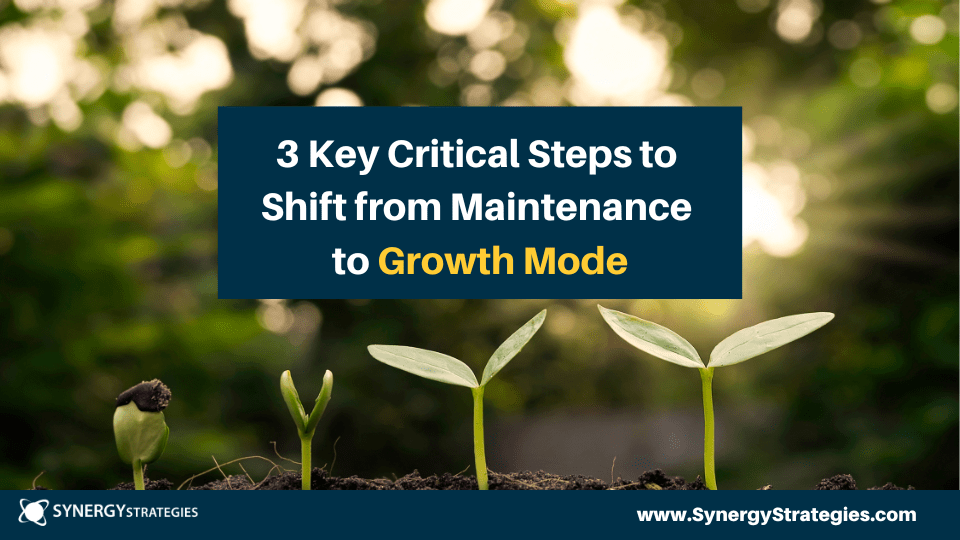As leaders, it’s essential to know when we have drifted into a maintaining/survival mode versus driving growth mode. The commonly said, “If you’re not growing, you’re dying” is a tough reality because the world is constantly advancing and moving so the lack of growth inadvertently creates regression just by not growing.
Ray Kroc, founder of McDonald’s would say, “You’re either green and growing, or you’re ripe and rotting.” In a healthy, energetic space we naturally choose growth. In a tired space, we drift to maintaining, which can easily turn into surviving. The difference between the two often comes down to mindset and actions. We often want the results of the growth mode but don’t realize that activity is what gets either maintenance or growth results. What we put in, impacts what we get out. Maintenance actions in = Survival Results. Driving actions = Growth results.
Sometimes we can feel weary and defensive about growth, wanting credit for the hard work done, craving a break, wanting the effort to be enough, struggling to find the energy to do more, and reconciling what we can sustain and give. This struggle can cause leaders to push back against the growth mindset and mode.
In the growth mindset and mode, it is not about 10xing results or doubling your income, but it is about a forward and evolving nature. When in maintenance, you can accidently be regressive not because you regressed but because the world moved forward while you were standing still. If you desire those growth results, here is a proven process to assess where you are and, more importantly, how to make sure you don’t drive into survival and instead stay in a growth-focused, high-performance mindset and mode.
Step 1: Recognize the Mindset You Are In
Start by taking an honest look at your current mindset and energy levels. Are you in maintenance mode or are you pushing forward with upskills, innovative and evolutionary thoughts, improvements, and advancements? Here are the 2 modes to help assess which one you might be in:
- Maintenance / Survival Mode: You feel tired, overwhelmed, and like you’re just getting through the day. There is more doubt, hesitation, and a sense of doing the minimum. Tasks feel heavy and even when you make progress, it doesn’t last long because you’re running low on energy. You know you are working hard and want credit for the progress made but the results are not showing up yet. You don’t want to be negative but inside you feel tired, a bit discouraged, and exhausted. You do not want to feel negative but do feel the grind or struggle inside to get further, move faster, or at least have more help or support. (Might shift to blaming or needing more from others, as you feel you have given everything you can). It is something that happens naturally in leadership when demands are high, in the midst of changing seasons, or buffering external pressures. It’s easy to drift into survival mode when resources are stretched, or when you’re focused on maintaining stability. You are getting through the day by doing what’s necessary. Tasks can feel heavier, and progress may come in bursts but doesn’t seem to last long. It’s a sign that your energy might be low, even though you are showing up and doing your best. All these are indicators you might be driving into the maintenance/survival mode.
- Growth Mode: In growth mode, you feel decisive, focused, and energized. You fail forward, trust yourself and your decisions, and there’s a sense of purpose behind your actions. You know your goals and focus on them, driving actions that will make them happen. You understand what it takes and are willing to do it. You might feel tired but ask “what else will it take” and push forward with confidence, knowing that your efforts are aligned with your long-term vision. There’s energy behind your actions, and you believe in the results you’re driving towards. You see the team and others as allies not enemies, partners not liabilities. You have a zeal and zest, a determination to make it happen. You dig into your reserves to find your resilience and strength because you know your mission matters. You look to learn, are curious, ask questions, and constantly scan to make things better, not for the sake of erratic and useless change but for continual improvement and leveraging opportunities as they present themselves. You are on the move and attracting (not pushing) people to move with you.
- Application & Action: Reflect on your mindset with compassion for yourself, your team, and your company. Are you more in a maintaining or growth mode/mindset? How are you in each and why? Recognizing this shift is key to resetting and recharging.
Step 2: Assess Your Surroundings: Are they in Maintenance to Survival or Driving to Growth Mode?
Once you’ve recognized your mindset, evaluate your surroundings—internally and externally. Leaders often unintentionally create a survival mode from their environment set up, working to maintain, but accidentally losing ground as the world moves forward. The “recipe” of our day creates our results. What is in your day that is helping you to get the results you are getting?
- Maintenance / Survival Environment:
- Perspective: Reacting to problems instead of proactively taking time to be in the helicopter, see the big picture and timely developments.
- Goals: Outdated, forgotten, or unclear goals that feel disconnected from your daily actions
- Team: A team focused on maintaining, not innovating (good enough mindset). Lack of training, accountability, or communication.
- Space: A cluttered or disorganized workspace that feel overwhelming, chaotic, and drains energy.
- Focus: Fire drills, hiccups, and nonsense that lead to circular activity, drama, squishy decisions, tolerations, and overwhelm.
- Growth Environment:
- Perspective: Taking key strategic time each day and week to be in the helicopter to communicate, check and verify, encourage, champion, and inspire the team toward the vision and purpose
- Goals: Clear, proactive goals that align with a bigger vision.
- Team: A team that’s engaged, motivated, and empowered to take ownership because they have had time and attention from leadership, feedback, and information to make better decisions, support to have obstacles removed, and clarity and direction to be able to do their part well.
- Space: An organized space and schedule that supports focus, prioritizing, and creativity.
- Focus: A sense of clarity and momentum toward achieving purpose and impactful results.
- Application & Action: Identify areas where your surroundings support survival and where they can be optimized for growth. Small changes—like organizing your workspace or aligning team objectives—can make a huge difference in your overall momentum.
Step 3: Shift to a High-Performance Growth Mode
The key to moving from maintenance/survival to drive/growth is aligning your actions and environment with the results you want.
Action Steps to Shift:
- Revisit Your Goals: What are your goals for yourself, your team, and your business? Where can you push for bold moves?
- Empower: Talk to the team about the vision, focus, and goals. Get their thoughts and insights on how you can achieve this together. Learn what is important to them and create a plan for who will do what, by when and how everyone will know. Create tracking to make sure progress is made weekly. Set milestone targets and celebrate wins so you can drive and push hard but not burn out.
- Prioritize High-Energy Actions: Focus on activities that energize and move you toward growth. Eliminate those that drain you or don’t align with your goals. What have you been doing that is not needed anymore? What needs to be adjusted or upgraded?
- Check-In Regularly: Stay accountable by setting check-ins to review progress and ensure you remain in growth mode, not slipping back into maintenance.
Application & Action: Start implementing growth actions today. Growth requires consistent effort and a proactive approach. Notice your energy and how you feel. Work on your goals and focus until you feel excited about it. If you are having a hard time finding the energy, consider talking to a coach to help recenter and refocus.
Often when in the maintaining mode, leaders can slowly find themselves feeling more behind and buried. Rather than waiting, tolerating, and delaying, thinking “Just get through this” or “It will be better in a few months”, make a commitment to shift things now. Generally, when people are stuck in urgent, the only way out of urgent is to make time for the important, even when they feel there is no time for the important. Likewise, the only way out of maintaining is driving, even when you feel you don’t have the time or energy for it.
The gap between survival and growth often comes down to whether you’re following a maintenance or growth recipe. If you want growth results, it’s crucial to stop operating in survival mode and intentionally create an environment that supports high performance. What mindset are you in right now? What are your environments nurturing and setting you up for? What changes are critical to align yourself for growth results?
https://www.synergystrategies.com/why-coaching-for-personal-growth/






